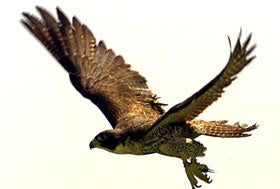City lights turn peregrines into night hawks

They carry out targeted killings on vulnerable victims and go on nocturnal rampages of violence and aggression. A new group of deadly predators has descended on Britain's towns and cities – but fear not, these urban clashes are taking place not on the streets but high in the air.
Peregrine falcons, the world's fastest birds, have moved into urban areas nationwide in the past 20 years, and have now learned to hunt other birds in cities at night – by street light.
The predators, which in the countryside and on the coast generally use cliffs as nesting sites, are using tall buildings including blocks of flats, power stations and medieval cathedrals to breed on and roost.
It is thought that more than 60 towns and cities, from Truro to Manchester, now hold a pair of peregrines, or single birds. London holds several pairs.
Increasingly, besides targeting feral pigeons, their principal prey, and other birds commonly found in urban areas in daylight, such as gulls and blackbirds, these super-efficient killers are chasing birds that migrate at night, using the glow from street lighting. They even catch bats. Their nocturnal hunting expeditions, largely invisible to human observers, are revealed by the remains of discarded prey under their nests and roosts, according to a new study in the April issue of BBC Wildlife magazine.
Ed Drewitt, a peregrine enthusiast, has spent 10 years collecting more than 5,000 food items from urban peregrine sites in Bristol, Bath, Exeter and Derby. Most of his finds are the remains of urban birds, with feral pigeons making up between 40 to 60 per cent of the total.
However, Mr Drewitt has also found the remains of non-urban birds such as water rails, moorhens, corncrakes, jack snipe, quails, and little and black-necked grebes. He writes: "Some of these are very shy species, usually staying close to vegetation and diving for cover at the first sign of danger.
"It is highly unlikely that peregrines could catch such elusive birds in their habitual lakes, ditches and pools. They must be taking them at night, when the smaller birds' journeys to and from suitable habitats take them over our towns and cities, where they are vulnerable to aerial attack."
Explaining how the falcons probably do it, Mr Drewitt writes: "Imagine a typical overcast and cold October evening. An urban peregrine takes up its hunting position on a high perch and waits, usually until a few hours after sunset.
"Once darkness falls, thousands of birds – grebes, gallinules (moorhens and coots) waders and passerines – will fly overhead on migration. The lights attract them closer to the city.
"Staying in the shadows, the peregrine watches as its targets pass overhead. Dashing out at high speed, the hunter flies up until it draws level with its prey. If the target fails to react quickly, the peregrine will swiftly overtake and seize it in its talons.
"After a successful hunt, the peregrine takes its prey to a favourite ledge to pluck and eat."
A zoologist who is a museum learning officer at Bristol's Museum & Art Gallery, Mr Drewitt, 28, says the peregrine's owl-like behaviour is not just a British phenomenon. Night-hunting peregrines have been recorded in other European cities from Berlin to Brussels, and cities further afield, such as New York and Hong Kong.
In the 1960s, peregrine populations fell in Britain because of the use of organochlorine pesticides, which built up inside the bodies of the birds they hunted, and made their eggs infertile. The pesticides were subsequently banned and the falcon's population has come back strongly. There are thought to be about 1,400 breeding pairs in Britain.
The speed of the peregrine's dive was measured by Swiss scientists 10 years ago and was shown to reach 115mph. This is much lower than the figure of 250mph given in many wildlife books. This, and the speeds estimated for other fast-flying birds, are now regarded as wildly exaggerated. But it still puts the peregrine ahead of its competitors.
Join our commenting forum
Join thought-provoking conversations, follow other Independent readers and see their replies
Comments
Bookmark popover
Removed from bookmarks